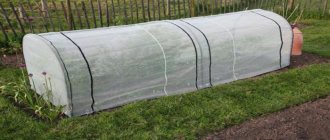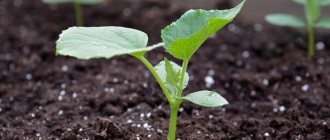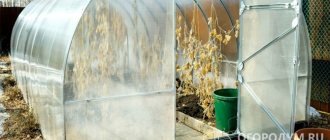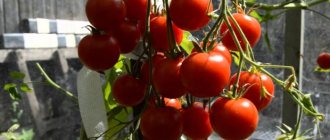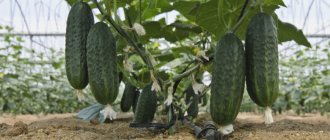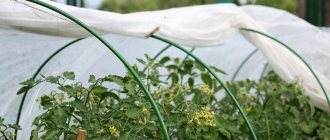Experienced summer residents share recommendations on choosing the right material.
It has long been proven that plants protected from adverse factors develop faster. If the owners of a suburban area want to get a large harvest of berries, vegetables, and herbs several weeks earlier, they need to use special covering materials.
Our readers ask how to select and use such materials.
Mouse1 FORUMHOUSE user
Please tell me if you have ever used (I don’t know what it’s called correctly) material to protect against weeds. Is it true that it allows water and sunlight to pass through? The family has a small child and time is running out, it’s a pity to start strawberries.
There are a lot of similar questions. We studied this topic and decided to share advice from experienced gardeners and summer residents on the correct choice of covering materials.
Purpose
Protective materials are used to shelter plants from adverse external influences. Innovative technologies are used in their production.
This allows you to get good results when growing garden crops:
- Increase productivity.
- Accelerate the process of fruit ripening.
- Protect plants from possible frosts in the spring.
- Reduce the amount of time required to cultivate beds.
- Reduce soil moisture loss.
The soil, covered with special films, does not overheat and does not dry out. There is no need to weed the beds often. You can cover the plants completely. In this case, a frame is created on which agrofibre is stretched, or the beds are simply covered with canvas. The edges are sprinkled with earth to ensure reliable fixation.
An important function of shelter is mulching. The soil can be protected from rapid loss of moisture and the development of weeds. Cover the beds with film, making holes in appropriate places. Seeds or seedlings are planted in them.
Application in different periods
In the spring, covering protects plants from frost, acting as insulation. Vegetables and greens develop faster as the soil and air under the film become warmer.
During the warm period, the soil can overheat and quickly lose moisture. The film will protect plants from drought, heavy rain with hail, and gusty winds. Non-woven agrofibre will protect the crop from pests. Watering and loosening the soil will need to be done less frequently.
In autumn, the film will protect plants planted in the ground at the end of summer. This is important for remontant varieties of berries, herbs and some vegetables.
Films are also used in winter. They are used to create shelter especially for heat-loving crops. They will not be afraid of frost, lack of snow on the ground surface, or strong winds. Experienced gardeners cover strawberries, onions, grapes, young trees and shrubs, and some types of perennial flowers.
Pest protection
In order to protect against above-ground pests, such as insects, it is best to use white non-woven material that is not of the highest density (the density will depend on how young and weak the sprouts are - light is used for small ones, denser for older seedlings).
You can cover the bed of unprotected soil with a white non-woven fabric immediately after sowing.
Experienced gardeners advise sewing bags of non-woven material individually for each head of cabbage. Thus, they will be reliably protected from all pests that encroach on the integrity of the leaves.
Varieties
All covering materials are made from polymers under high pressure and temperature. They differ in density, structure and additional properties. All subspecies can be divided into two large groups:
- Polyethylene film. It can be transparent or cloudy. Films are used to cover the frame under which tomatoes, strawberries, and peppers are grown. Onions and garlic, as well as root vegetables, grow well under such cover.
- Non-woven agrofibre. This type of shelter is also called agrofabric or spunbond. The polymer is not only melted, but also passed through dies. The result is continuous threads or fibers. They are fastened into a fabric with impregnation or stitched with a needle. These are soft and lightweight types of shelters. They can be laid directly on plants without a frame. Shrubs are wrapped in non-woven materials for the winter and used for mulching the soil.
It is important to know the advantages and disadvantages of the presented shelters.
Shading grid
Shading mesh can also be considered a covering material. It is made from polypropylene with the addition of an ultraviolet stabilizer. Often in stores there is a green color option, but there is also a neutral white color. Nets of the required size are made to order, the standard width is 4 m. The material is used to protect agricultural plants from the scorching sun: they cover greenhouses, grapes, and young fruit trees. Used to collect fruits, spread under trees
When choosing a material, the main criterion is your expectations and the effect of application. If you need protection from return frosts, then white spunbond or film is suitable. Black materials are suitable for mulching. Of course, everything depends on the financial side of the issue. But if you are engaged in growing crops on an ongoing basis, then it is worth investing once rather than spending money and time every year on purchasing and installing a shelter.
Advantages and disadvantages of film
Summer residents often use films in their gardens. This group of shelters is characterized by the following advantages:
- Protects from frost and frost.
- Excellent light transmission.
- They are inexpensive, so they are used over large areas.
- Do not release heat from the shelter.
The disadvantages of polyethylene films are:
- Can only be used on arches. The material is quite heavy, so you cannot lay it directly on the plants.
- They do not allow water to pass through. Watering plants requires more effort and time.
- The beds are periodically ventilated so that the temperature does not rise to a critical level. Otherwise, the plants will die.
- Strong winds wear out the film on the edges of the frame.
- Condensation accumulates on internal surfaces, which can cause diseases on plants.
- The films sag under the weight of sediment.
- The service life does not exceed one season.
Advantages and disadvantages of agrofibre
Agrofabric is characterized by a wide range of applications. It has a number of positive qualities:
- Durability. When used correctly, agrofabric does not lose its original qualities for 5-6 years.
- The fiber weighs little. It will not break the stems of even tender seedlings.
- Two pieces can be sewn by increasing the width of the fabric.
- It allows moisture and air to pass through, which prevents water from stagnating and condensation forming.
- When mulching, it prevents weeds from growing in the beds.
- Watering is carried out without removing the material. This greatly simplifies the care of garden crops.
Agrofabric has much fewer disadvantages. These include the following:
- The cost is higher than that of film. But given the service life, agrofibre is cheaper.
- When sewing the edges, it will not be possible to achieve uniformity of the fabrics.
Non-woven covers are used in the cultivation of almost all garden plants. When choosing a suitable canvas, a number of parameters are taken into account.
Polyethylene films
Polyethylene film does not lose its position. The first thing that attracts you is the price. Regular film will only withstand one season of exposure to sunlight. In order to slow down the destruction process, manufacturers add stabilizers. Light-stabilized material usually differs from ordinary polyethylene in color, which does not affect the properties, but indicates the type of film. There are such varieties:
- Ethylene vinyl acetate film with an EVA prefix will last at least five years. To the touch it can be distinguished from the usual one; it is more rubber-like. Durable and elastic, not afraid of frost, transmits sunlight well.
- Hydrophilic film with a blue tint is resistant to ultraviolet radiation. The composition contains special components that prevent the formation of condensate water droplets. Excess moisture flows down the surface in streams.
- The greenish tint of the film indicates its heat-retaining properties. It retains heat well at night; under this coating it is 5 degrees warmer than under regular film.
Protecting beds with films - The reddish or orange film converts ultraviolet radiation into infrared. This has a beneficial effect on plant growth. The film differs in its dispersion coefficient. If in the south you need a film with protection from excess radiation, then in the north, on the contrary, it is necessary to increase the glow, since there is less sunlight here.
- The film with air bubbles has two or three layers. Air bubbles are hermetically sealed between the layers, which retain heat well. The thermal protection of such a material is tens of times greater than usual. There is one caveat: the larger the air bubble, the better it transmits ultraviolet radiation, but the strength of the film decreases.
Reinforced film - Fiberglass reinforced film is suitable for the walls of a greenhouse, as it cuts off about 30% of sunlight. When the film breaks, glass fibers prevent further spreading of the material.
Advice. Breathable films include reinforced polyethylene with punched holes. This is a relatively new material on the market. The tunnels above the beds are covered with transparent film.
Density
Our regular reader Egenii asks: “The soil is heavy plasticine black soil. It was virgin land last year, now it has partially rotted over the winter, turned over with a plow, and plowed several times with a walk-behind tractor. Actually, the question arose of how to plant so that weeds do not attack the plants. Krasnodar region, it’s hot at times...if you take a thick covering 60 and mulch with straw, will it do any good or will the plants die?”
One of the important parameters of agrofibre and film is their density. Based on this criterion, the following groups of paintings are distinguished:
- 14-17 g/m². Used for direct placement on plants. Low density makes the canvas light. As they grow, the shoots are raised and covered. Agrofabric and film with this density are used in low beds. The edges must be weighted so that the flooring does not blow off the wind.
- 20-42 g/m². This is a universal, most common type of film, agrofabric. It is used in the construction of greenhouses on steel arches or rods. Vegetable seedlings and flowers develop well under such shelter. The density is high enough to withstand wind and rain.
- 43-60 g/m². This is a cover for full-fledged greenhouses used throughout the entire gardening season. The harvest is protected from birds, spring frosts, and overheating in summer. Winter crops are covered with thick canvases. The material of this group is suitable for heat-loving plants.
- Over 60 g/m². These are the densest and heaviest films. They are used for mulching beds. Dense varieties create a greenhouse effect on the ground. The soil warms up faster and becomes suitable for planting a couple of weeks earlier. Shoots pass through the holes. To do this, cross-shaped or round slits are made in the canvas.
Covering material for strawberries and other types of berries and vegetables
Protective coverings made of polypropylene were first used for greenhouses using a frame base. But it soon turned out that if you reduce the specific gravity of such material, it can also be successfully used in garden beds. For example, for strawberries, the density of polypropylene fibers should be from 17 to 30 g/cm³ of surface. This coating used for this berry is excellent for growing raspberries, cucumbers, potatoes and peppers. The lightest materials (with a density of 17 g/cm³) are used to cover early greens: dill, parsley, onions and basil.
Strawberries feel great under the covering material. The absence of problems in caring for plants makes it possible to reduce the labor costs of gardeners for growing this crop several times.
Covering material allows to reduce the labor costs of gardeners when growing strawberries
As a result of using this type of material, we get a number of advantages: strawberry yields increase significantly, berries ripen faster under cover, and the beds are not afraid of frost. In addition, during dry periods, moisture loss is reduced - therefore, water spent on irrigation is saved. It becomes virtually impossible for birds and harmful insects to reach the crop.
Helpful advice! The prices of covering material for beds from different manufacturers do not differ too much. Pay attention not so much to the cost and brand, but to the density of polypropylene.
With a relatively modest financial investment, you can equip a strawberry bed with a drip irrigation system. It will pay for itself within a few years by saving water and electricity. At the same time, it will eliminate the difficulties of watering berry crops through holes in the substrate. Plant roots will never dry out, producing stable shoots and abundant harvests.
It is recommended to plant strawberries on black covering material in spring and autumn.
Planting strawberries on black covering material can be done in spring and autumn. It is recommended to grow this crop in one bed for three to four years in a row. Agricultural experts emphasize that when young seedlings are used for planting, their yield will increase every year, regardless of the chosen strawberry variety.
Color
Participant kler26 writes the following: “Has anyone used black agrofibre to cover the ground in garden beds to prevent weeds? I had some trouble with him. Maybe I'm doing it wrong. I only water each hole; the water washes away the soil, leaving bare roots. That's why I add soil regularly. The weed also grows under the fiber. you have to stick your hand in and somehow pull them out - it’s very inconvenient. In addition, the fiber periodically pokes out from under the ground, so you have to crawl and cover it with new ones. I thought it would be easier with him, but something turns out to be more troublesome.”
The canvases differ in color, which is also chosen in accordance with the area of application. They are suitable for the following purposes:
- Black. Used in cold regions. They attract sunlight, so the soil warms up faster. Even before planting the plants, the beds are lined with material. After 1-1.5 weeks, the soil becomes suitable for sowing.
- White. Reflects light, preventing weeds from developing. Slots are made in the canvas for plants. Shoots located above the material receive more light.
- Black and white. The canvases are white on one side and black on the other. They are spread directly onto the beds. The black side faces down. This prevents grass from growing. The white side reflects the sun's rays, preventing overheating of the soil and plants. The material is used for vegetable gardens in warm climates. You will need to water and weed the beds less often.
- Green. It is used for near-trunk decoration and for mulching the soil. Creates a beautiful landscape near the house and prevents the germination of weeds.
Other Important Features
Covering materials differ in some other features. The width of the canvas is 1.5-3.2 m. It is not recommended to connect the strips. This degrades the performance of the shelter. Therefore, it is necessary to select a roll whose width corresponds to the size of the bed. Its edges should protrude 10 cm beyond the treated area. They are sprinkled with soil or pressed down with logs.
Some films and agrofabrics have reinforcement. This is a rigid lattice mesh that increases the service life of the material. It prevents the fabric from quickly rubbing, which is especially important when stretching it onto the frame. Reinforced fabrics are used in regions where strong winds blow.
The covering material may have an ultraviolet stabilizer. Such varieties are marked “SUF”. If the amount of sunlight in the region is insufficient for the growth of certain types of crops, this variety is used. The film converts light into infrared rays, which affect the sprouts longer and more gently. Even in the evening, crops receive sufficient light.
What is the name of covering material for beds: its types
Materials intended for plant protection are most often called spunbond, agrotextiles and agrofibre. From a technical point of view, these are different names for the same covering product. In practice, only the specific gravity and color of materials, their ability to retain ultraviolet radiation and transmit water are important. Geotextiles occupy a special place among such products. It has a higher density than other analogue covering fabric. The use of geotextiles by gardeners is limited to creating a substrate for growing plants. In this way, effective weed control is carried out.
Covering material for beds is called spunbond, agrofibre or agrotextile
The average shelf life of agrofibre is 6-7 years, and geotextiles (as a more durable analogue) last even longer. Such a long period of operation makes it economically feasible to purchase covering materials as opposed to quickly tearing polyethylene.
Covering material for beds: varieties and purpose
There are three main functional types of these “blankets” intended for growing plants in the garden:
- black dense non-woven materials, as well as garden geotextiles - they are used to control weeds;
- medium-density varieties of white spunbond and its analogues, which cover plants during cold periods of the year;
- light white covering materials that protect crops from frost in the spring and from excessive heat in the summer.
Black covering material is the densest type of fiber
For certain types of garden crops, agrofabrics are produced in gray and green colors. Regardless of the density, these materials do not require the construction of a frame when laid on the ground. Black weed film is used to mulch the ground, white agrofibre is used to reflect the visible part of the spectrum of sunlight and to absorb infrared rays. Regardless of color, all types of covering materials are designed to allow moisture to easily pass to the roots of plants, and air to their leaves.
A special type of agrofibre is designed to create shading nets. With their help, plants are not allowed to wither under the powerful stream of solar ultraviolet radiation. This mesh is stretched over a lightweight frame in the form of a dome-shaped structure. In addition, it protects the crop from encroachment by birds.

